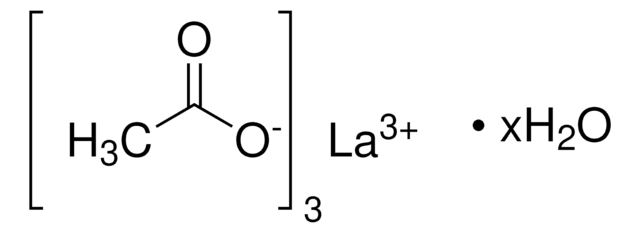Wichtige Dokumente
203548
Lanthan(III)-nitrat Hexahydrat
99.999% trace metals basis
Synonym(e):
Salpetersäure, Lanthan(III)-Salz, Hexahydrat
About This Item
Empfohlene Produkte
Qualitätsniveau
Assay
99.999% trace metals basis
Form
solid
Eignung der Reaktion
reagent type: catalyst
core: lanthanum
Verunreinigungen
≤15.0 ppm Trace Rare Earth Analysis
mp (Schmelzpunkt)
65-68 °C
SMILES String
[La+3].[H]O[H].[H]O[H].[H]O[H].[H]O[H].[H]O[H].[H]O[H].[O-][N+]([O-])=O.[O-][N+]([O-])=O.[O-][N+]([O-])=O
InChI
1S/La.3NO3.6H2O/c;3*2-1(3)4;;;;;;/h;;;;6*1H2/q+3;3*-1;;;;;;
InChIKey
GJKFIJKSBFYMQK-UHFFFAOYSA-N
Suchen Sie nach ähnlichen Produkten? Aufrufen Leitfaden zum Produktvergleich
Allgemeine Beschreibung
Anwendung
- α-aminonitriles by a one-pot three-component coupling of the carbonyl compound, amine, and TMSCN.
- Acetals and geminal diacetates (acylals)from aldehydes.
- Bis(indolyl) methanes under solvent‐free conditions.
Leistungsmerkmale und Vorteile
- Thermal stability
- Low toxicity
- Mild reaction condition
- Chemoselectivity
- Low cost
Signalwort
Danger
H-Sätze
Gefahreneinstufungen
Aquatic Acute 1 - Aquatic Chronic 1 - Eye Dam. 1 - Ox. Sol. 2
Lagerklassenschlüssel
5.1B - Oxidizing hazardous materials
WGK
WGK 2
Persönliche Schutzausrüstung
Eyeshields, Gloves, type P3 (EN 143) respirator cartridges
Hier finden Sie alle aktuellen Versionen:
Besitzen Sie dieses Produkt bereits?
In der Dokumentenbibliothek finden Sie die Dokumentation zu den Produkten, die Sie kürzlich erworben haben.
Kunden haben sich ebenfalls angesehen
Artikel
Spectral conversion for solar cells is an emerging concept in the field of photovoltaics, and it has the potential to increase significantly the efficiency of solar cells. Lanthanide ions are ideal candidates for spectral conversion, due to their high luminescence efficiencies and rich energy level structure that allows for great flexibility in the upconversion and downconversion of photons in a wide spectral region (NIR-VIS-UV).
The prevailing strategies for heat and electric-power production that rely on fossil and fission fuels are having a negative impact on the environment and on our living conditions.
The rare earth elements impact nearly everyone in the world. All of the people living in advanced technological countries and almost all those living in third world countries utilize the rare earths in their everyday living—the car that one drives (gasoline is refined from oil using rare earth catalysts and catalytic converters reduce the polluting emissions from the automotive exhaust), watching the news on TV (the red and green colors in TV screens), the telephones and computers we use to communicate (the permanent magnets in speakers and disc drives), just to name a few examples.
Unser Team von Wissenschaftlern verfügt über Erfahrung in allen Forschungsbereichen einschließlich Life Science, Materialwissenschaften, chemischer Synthese, Chromatographie, Analytik und vielen mehr..
Setzen Sie sich mit dem technischen Dienst in Verbindung.














